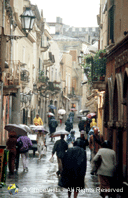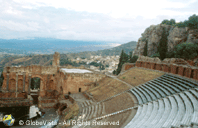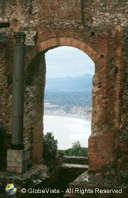Taormina is nestled high on the cliffs of Mt Tauro overlooking the Ionian Sea and the temperamental volcano Mt Etna, on the island of Sicily (the largest island in the Mediterranean) in Italy.
Brief History
 Taormina was established around 358 BC and was known as Tauromenion by Greek refugees from Naxos whose city was destroyed during colonial wars in the 5th century BC by tyrant Dionysius the Elder. The town became a typical Greek colony including an impressive amphitheater. The town eventually came under Roman domination around 212 BC.
Taormina was established around 358 BC and was known as Tauromenion by Greek refugees from Naxos whose city was destroyed during colonial wars in the 5th century BC by tyrant Dionysius the Elder. The town became a typical Greek colony including an impressive amphitheater. The town eventually came under Roman domination around 212 BC.
During this time the area became a popular resort area for consuls and politicians who built many luxurious villas. Romans continued to place heavy taxes on the city subsequently blocking economic development of the area.
When Syracuse became a less important town, following the fall of Constantinople and the fall of the Empire, Taormina became the capital of Byzantine Sicily. This was a period of grandeur, but like all good things, it would end abruptly in 902AD when the city was conquered by Arabs and was renamed Almoezia.  Even though much of the city was destroyed by the Arabs it was a good period of progress for the city in the areas of agriculture, philosophy, and medicine. The Arabs occupied Taormina from the 9th to 11th centuries.
Even though much of the city was destroyed by the Arabs it was a good period of progress for the city in the areas of agriculture, philosophy, and medicine. The Arabs occupied Taormina from the 9th to 11th centuries.
In 1078 the Normans, led by Ruggero d’Altavilla, took over the area and were responsible for restoring the Christian religion. Many monasteries were built during this period and the city took back its original name Taormina. Next came the Spanish who did very little in the way of improving the area and it became a period of political and economic stagnation due mainly to the heavy taxes.
In 1711 the Spanish domination ceased and for a short period, the town came under Savoy control.
Things You May Not Know About Taormina
 DH Lawrence lived (self -exiled) in Taormina between 1920 and 1923 where he was inspired to write Lady Chatterley’s Lover.
DH Lawrence lived (self -exiled) in Taormina between 1920 and 1923 where he was inspired to write Lady Chatterley’s Lover.
Taormina is only about 200m above sea level, though it seems so much higher.
Evidence discovered on one of the seats at the Greek Theatre suggests that reserved seating was in full swing over two thousand years ago. The inscription bears the name ‘Philistide, wife of Hieron II of Syracuse’.
 The city’s Duomo is not really a cathedral but a Norman-Arab church.
The city’s Duomo is not really a cathedral but a Norman-Arab church.
Taormina was one of the first Sicilian cities to support Rome during the Punic Wars.
In Mythology it was believed that Mt Etna was where Vulcan (Roman god of fire and metalworking) kept his forge and where Enceladus (a giant defeated by Jupiter) was buried.
Controversial German photographer Baron Wilhelm von Gloeden made his home in Taormina in the 1800s. He is widely renowned for his photographs of nude boys in various Sicilian settings. In 1915 Gloeden had to leave Taormina when Italy entered the First World War against Germany. On his return in 1919, he was devastated to discover many of his models had died in combat. Wilhelm von Gloeden died in 1931 in Taormina. Only a quarter of his negatives survive today.
